The Lodi Life & Times
In Lodi, wine comes first. And we wouldn’t have it any other way.
Meet the passionate people behind our handcrafted wines and
gnarly old vines.
Lodi in the news in 2019

Glasses of Lodi wine enjoyed between bicycle sprints through Lodi wine country vineyards (photo courtesy of Gabrielle Lurie Photography)
Over the past year, in 2019, Lodi wines and Lodi wine country have been the subject of articles by some of the most talented wine journalists and bloggers in the country.
It feels good, of course, to garner praise, and it feels even better to be appreciated as a result of something seemingly so simple: members of the media actually taking the time to visit and experience Lodi for themselves, which of course is the best and most logical way for anyone to form an opinion about anything or any place.
Of all of the past year's articles, the one by Esther Mobley, the widely respected wine critic for the San Francisco Chronicle, hits the nail on the head in most direct fashion. The title of Mobley's missive was We've gotten it all wrong about Lodi wine.
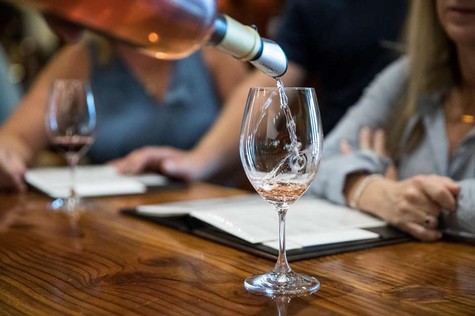
Tasting of LangeTwins Family Lodi rosé (photo by Laura Morton, courtesy of San Francisco Chronicle)
The first two paragraphs in this November 7 piece:
Before I moved to California to begin my job with The Chronicle, I didn’t know much about Lodi wine — and I honestly didn’t think there was much to know. My only real exposure to the region came while working at an East Coast wine shop; the Lodi wines we sold there were cheap, jammy and sickly sweet.
Oh, but how wrong I was. Discovering the wines of Lodi has truly been one of the great pleasures of my job over the last few years. Like many California wine drinkers, I initially got interested in Lodi because I saw that talented minds from Napa and Sonoma like Abe Schoener, Mike Officer and Duncan Arnot Meyers and Nathan Lee Roberts were buying fruit from there — and, in the cases of winemakers Tegan Passalacqua and Morgan Twain-Peterson, even buying land. Last year I wrote a story about Passalacqua’s plans to build a winery in Victor, near the Lodi sub-AVA of Mokelumne River, for his Sandlands label. And this spring I wrote about Lodi’s Bechthold Vineyard, a remarkable site that contains the world’s oldest planting of Cinsault — and results in some stellar bottles from wineries like Birichino and Two Shepherds.
Mobley's story is interesting in two ways. First, her reference to "cheap, jammy and sickly sweet" wines. We presume that the wines she is referring to are inexpensive wines (sold for, say, less than $10, hence "cheap"), and wines that have a certain level of fruitiness or often sweetness deliberately produced to appeal to consumers who buy $10-and-under wine. The fact of the matter is, over 60% of all wine sold in the U.S. is still under $9 (re Silicon Valley Bank's thoroughly fleshed-out State of the Wine Industry Report 2019). Face it: most American wine consumers are on the frugal side, and they might not know a lot about wine beyond the fact that they prefer them fruity and easy drinking. They probably don't pay much attention to persnickety critics or punctilious pundits either; but hey, they're wine lovers like any other!
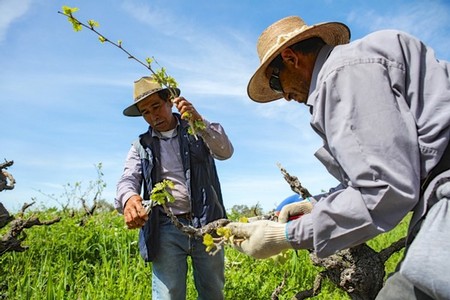
Winter pruning in Lodi's Stampede Vineyard (photo courtesy of Gabrielle Lurie Photography)
The reason why Lodi is easily the largest winegrowing region in the U.S. (as we often remind everyone, Lodi cultivates more acres of wine grapes than Sonoma County and Napa Valley combined) is because it supplies most of the grapes for the "big" (or "gigantic," in the case of E. & J. Gallo) wine producers who stock our grocery shelves with value priced bottles and, most recently, more choices of "wine-by-the-box" and even handy-dandy cans. In the olden days — going back to the 1960s or '70s — these were called "jug wines" because most of them came in hefty 1 gallon or 1.5 liter bottles with built-in glass handles.
But as we also like to remind everyone, not all of the grapes going into the jug wines of olde came from Lodi. In fact, most of it used to come from Sonoma County and Napa Valley. Why? Because up until the '70s Sonoma and Napa grape prices were still low enough for the big companies to source their everyday-priced wines. Does that mean Sonoma and Napa were only good for "cheap, jammy and sickly sweet" wines? Of course not. These were, and obviously still are, great wine regions. And like Napa and Sonoma, the climate and soils of Lodi are extremely amenable to high quality wine production. Thank goodness, wine critics like Mobley are finally able to come to this conclusion.
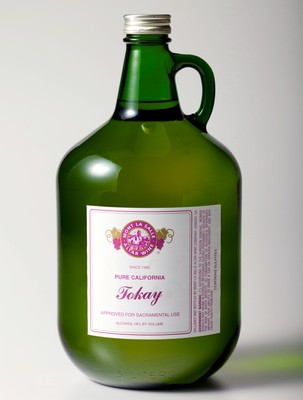
Old school jug holding a medium-sweet 18% alcohol altar wine by Mont La Salle (a Christian Brothers-owned winery that sourced most of its grapes from Napa Valley and Sonoma County during most of its history, dating back to 1882)
The second interesting thing about Mobley's article is that she confesses that the only reason she's woke to Lodi's built-in attributes is because of "talented minds" of winemakers based in Napa or Sonoma who have not only been buying fruit from Lodi, but in some cases are even snapping up Lodi vineyards for themselves. We get that. "Outside" endorsements count. If that's what it takes to get attention from media, trade or more sophisticated consumers, we'll take it.
Our hope, of course, is that critics and reporters like Mobley will also soon recognize that there are "talented minds" growing and producing wines within Lodi itself. Not all the geniuses live in Napa or Sonoma counties. Especially our Lodi winegrowers who have been doing it for three, four, and even five or six generations. After 50 or over 100 years, people (or, we should say, families) get good at what they do, and we're proud of that (for our most recent profiles of many of these multi-generational talents, please see our post entitled Portraits of Lodi's passionate vignerons).
To read the rest of Mobley's insightful article, please visit the San Francisco Chronicle Web site. And for even more edification, here are some of best (IOHO!) articles on Lodi wine from the past calendar year:
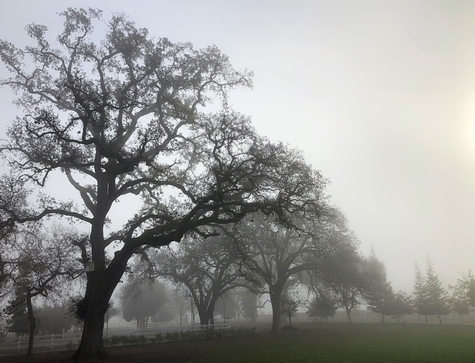
Lodi "Oak morning" by Elaine Brown (photo courtesy of Hawk Wakawaka Wine Reviews)
Hawk Wakawaka Wine Reviews — Visits to Lodi over 2019
By Elaine Brown
December 20, 2019 — Soon after first moving to the North Coast, when I started working in wine, I was able to spend time in Lodi learning about the region. My first visit, local legend Randy Caparoso generously hosted me and drove me around for more than a week of 14-16 hour days. I returned again later that same year for 5 days in harvest. And have been able to continue to visit the region in the years since in pop-ins of a day or few days at a time.
Studying Lodi has offered me the opportunity to better think through California history, its history of innovation, and the intricacies of the wine business in general. As a region it has been integral to the success and evolution of California wine, but as a region of growers it has at the same time garnered less attention than other regions, some of which also rely on its fruit. Reasons for this are varied, but regardless, I spent this year spending time with a range of people in Lodi listening to the history of their work, their families, and their knowledge of the region as a way to trace the lines of what is part of a behind-the-scenes legacy of California wine.
People have been incredibly generous with their time and I’ve been lucky to have the opportunity. All together, it’s amounted to several weeks in Lodi over numerous visits beginning in May and going at different times until December. Following is a collection of Instagram posts I shared along the way in many of these visits to Lodi. As they are from across this year they include information from multiple seasons as well. Read more.
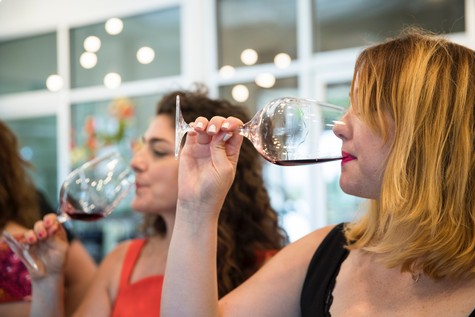
Wine tasters at Lodi's Bokisch Vineyards (photo by Laura Morton, courtesy of San Francisco Chronicle)
The Press — Lodi leads California wine regions in sustainability
By Mike Dunne (for San Francisco Chronicle)
November 5, 2019 — In the family portrait of California wine regions, Lodi is the big guy off to the side in the row at the back. He is sunburned and sweating, his hair tousled by maritime breezes off the Pacific Ocean just to the west. He is older than he looks, more complex than his quiet manner suggests.
Other members of the family have taken advantage of his good nature for decades, only occasionally giving him credit for his character.
But now Lodi is showing new confidence, speaking to resourcefulness, adaptability and value with a newfound clarity and a surprisingly expanded vocabulary...
Nevertheless, Lodi’s standing as a fine-wine region has been slow to develop, in large part because its grapes got lost in bulk wines exploited anonymously by brands beyond the region, including Sonoma County and Napa Valley. Several of California’s more influential wine families – Sebastiani, Trinchero, Martini, Mondavi, Gallo – recognized the quality of the grapes that Lodi was capable of yielding but generally used their juice for jug wines and “fighting varietals” that bore the “California” appellation rather than “Lodi.”
That began to change with the creation of a defined Lodi American Viticultural Area in 1986, followed five years later by the establishment of the Lodi Winegrape Commission and its ambitious and successful early campaign to persuade wineries to put “Lodi” on their labels.
In 2005, the commission orchestrated two more developments to help set Lodi apart from other wine regions. One was to subdivide the massive Lodi AVA into seven smaller AVAs – Clements Hills, Sloughhouse, Alta Mesa and so forth – thereby recognizing the varied soils, topography and microclimates in the region.
The other was to introduce “LODI RULES,” the state’s first independently certified winegrowing program aimed at balancing environmental, economic and social concerns. That first year, six families farming 1,455 acres agreed to subscribe to 100 standards concerning pest, soil, water and other management practices to enhance sustainability. Today, 85 families farming 24,200 acres adhere to the standards, representing more than a fifth of Lodi’s winegrape acreage. Read more.
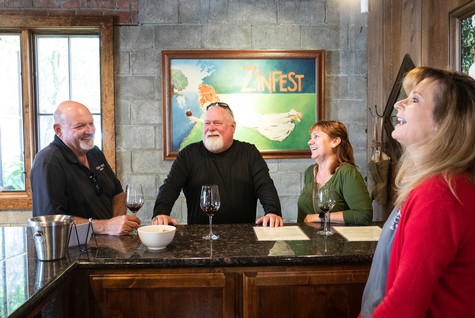
Klinker Brick Winery owner/grower Steve Felten (left) entertaining visitors (photo by Laura Morton, courtesy of San Francisco Chronicle)
The Press — What's hot in Lodi: unusual grape varieties
By Mike Dunne (for San Francisco Chronicle)
November 5, 2019 — For generations, Lodi’s wine growers have been pretty much stuck on hardy black grapes – Alicante Bouschet, Petite Sirah, Carignan and, most of all, Zinfandel.
Such varieties took hold here because they thrived in the area’s sunshine, soil and heat, stood up to punishing rail trips east in the Prohibition days when growers shipped grapes to home winemakers, and provided the fruity flavors, deep coloring and sound structure that laid the foundation for California’s wine trade: blended jug wines of character and value.
These potent, dark grapes are still around, especially Zinfandel, but a whole bunch of new kids are moving into the neighborhood. Many of them look different – several have green skins, for one – and they often behave differently, producing wines leaner, sharper and drier than the fleshy and lusty style for which Lodi long has been recognized.
The newcomers include grapes long identified with France’s Rhône Valley (Picpoul Blanc, Mourvèdre, Syrah) or the Iberian Peninsula (Tempranillo, Garnacha, Albariño) or Germany and Italy (Gewürztraminer, Vermentino, Kerner).
No one reason accounts for the growing diversification of Lodi’s vineyards. Some growers and winemakers simply don’t want to be solely dependent economically on the region’s flagship grape varieties. Others see an opportunity to set themselves apart from the rest of the pack with styles of wine likely to appeal to consumers tired of standard varietal wines or otherwise eager to discover something new.
Implicit in this new exploration of alternative varieties is an awareness of and confidence in the Lodi soil, topography and climate to support a wider range of grapes. Anyone driving around Lodi well may conclude by its flat terrain and persistent sunshine that it doesn’t offer much diversity in the characteristics that constitute terroir, such as soil composition, temperature and exposure. Read more.
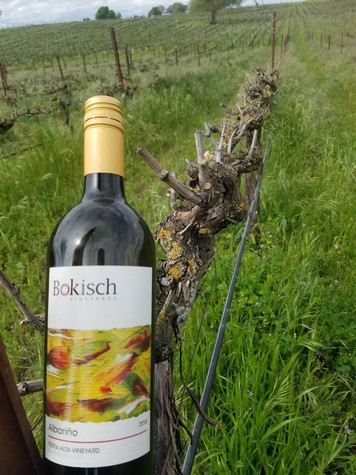
Bottle of Bokisch Vineyards Albariño at its Clements Hills-Lodi source, Terra Alta Vineyard (photo courtesy of Todd Godbout)
WineCompass — Lodi Wine: Albariño Ascending
By Todd Godbout
April 26, 2019 — "When I first tasting Albariño, I became very excited about this grape and knew we had to grow it", Steve Felten, Owner/President Klinker Brick Winery
As a result in 2013, Felten regrafted 10 acres of under-performing Chardonnay in Ted's Vineyard (alongside Alpine Road) with the Rías Baixas clone. In this regard, he leveraged the earlier work of Markus Bokisch who first planted Albariño in Lodi wine country back in 1999 and provided the vines to Felten. Today there are still only a handful of Lodi wineries producing Albariño, but the grape's potential is clear. Our Snooth group recognized this potential the very first evening during a dinner at Oak Farm Vineyards after sampling the Klinker Brick Winery 2018 Lodi - Mokelumne River Albarino ($15) and the Mettler Family Vineyards 2017 Estate Albariño ($20). Both of these wines were very reminiscent of their Spanish contemporaries.
Albariño is the signature grape of the Rías Baixas Denominación de Origen (DO) wine zone in the Galicia region of northwest Spain. It is the Irish region of Spain based on its past Celtic heritage, proximity to the ocean, and abundant rainfall which provides lush landscapes. Mists and fogs cool the region further and vines are planted on pérgola trellising systems that are up to seven feet high allowing breezes to flow through to prevent mildew. This coolness helps the grapes retain acidity but despite the rainfall, Rías Baixas is blessed with abundant sunshine. The soils are primarily mineral based granite with lesser amounts of alluvial and colluvial soil (clay, silt, sand, and gravel) deposited from the region's many rivers and tributaries.
Rías Baixas wines are characterized by their intense aromatics, minerality, and crisp acidity however there can be noticeable diversity within and between the region's five sub-zones. In most instances, green apples are the dominant fruit, but one can often ascertain apricots and peaches or more tropical notes from warmer sub-zones located further from the ocean.
The Klinker Brick and Mettler Family Albariños both share the classic Rías Baixas style as did the Bokisch Vineyards 2017 Clement Hills Terra Alta Vineyard Albariño ($20). These wines are characterized by a pronounced floral aroma; green apples and citrus; noticeable minerality; and racy acids. In fact, during a blind tasting of new vs old world white wines, the Bokisch TAV Albariño tasted closer to Rías Baixas than the Palacio de Fefinanes Albariño de Fefinanes which had appreciable new world qualities such as intense stone fruits and shades of honey. This perception was most likely the result of the Lodi wines' distinct minerality which Felton attributes to the dense sandy loam near the Mokelumne River. And in the case of the Bokisch TAV Albariño, the Clement Hills soil closely mimics those in Rías Baixas where volcanic, gravelly, clay loam washed down from the Sierra Foothills. Jorja Lerner, co-owner of Harney Lane Winery, also attributes Lodi Albariño's resemblance to Rías Baixas to the "temperature shifts contributed to the Carquinez Strait which brings a bit of the coast all the way to Lodi, essentially warm days and cool evenings." Read more.
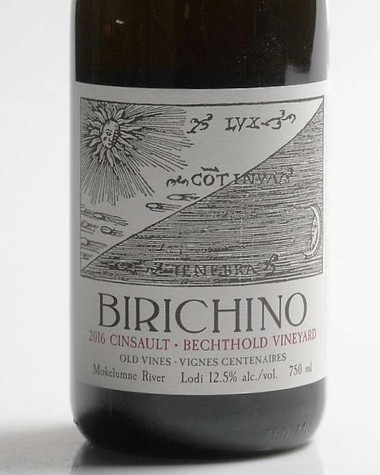
San Francisco Chronicle — The uniquely ethereal Cinsaults of Lodi's Bechthold Vineyard
By Esther Mobley
March 15, 2019 — Any Bechthold Cinsault will completely confound the typical perceptions of Lodi wines — maybe even of California wines. These are pale, limpid reds that pack an amazing amount of pure, fresh fruit flavor into extremely light frames, always with a troupe of warm earth flavors in the ensemble. You’d be forgiven for mistaking some of them for Pinot noir or Gamay; the vineyard’s particular mixture of fruit, earth and lightness strongly recalls Beaujolais. If you’re familiar with Cinsaults from southern France, like the excellent version from Domaine d’Aupilhac, which inspired some of these winemakers to include stems in their Bechthold fermentations, the Bechthold Cinsaults will still be a fresh, pleasant novelty. (Note: Some producers use the alternative spelling “Cinsaut.”)
These are believed to be the oldest Cinsault vines in the world, and are among California’s great viticultural treasures. It’s truly astonishing that it took over a century for Bechthold’s plant material to be correctly identified and its fruit used for ambitious wines.
Fields Family Cinsault Bechthold Vineyard Lodi 2016 ($26, 12.5%): Winemaker Ryan Sherman’s rendition is textbook Bechthold: anchored in bright red fruit flavors — raspberry, cranberry — made interesting by an earthy aspect, recalling terra-cotta. The acid is screeching, the midpalate plump. Read more.
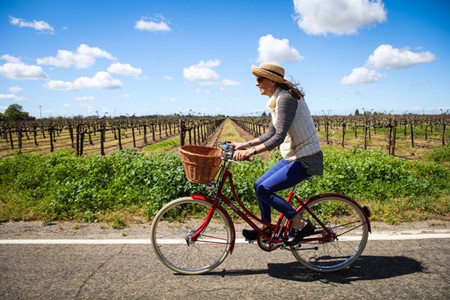
Bicycling through Lodi wine country (photo courtesy of Gabrielle Lurie Photography)
Lodi — bikeable wine capital of the San Joaquin Valley
By Brian Coyne (for San Francisco Chronicle)
November 5, 2019 — It’s a great injustice that many people who’ve never been to Lodi, in San Joaquin County, know it only from the eponymous 1969 Creedence Clearwater Revival song, with its down-and-out chorus: “Oh Lord, stuck in Lodi again.” But it’s telling that John Fogerty, then the lead singer and songwriter for CCR, said later that he had never been to Lodi when he wrote the song and chose it only for the sound of the name.
If Fogerty had been, he would have known: Lodi’s relaxed charms make it more a place to visit on purpose than to get stuck in.
Today this city of 66,000 people, which sits just south of the Mokelumne River between Stockton and Sacramento, is building a reputation as one of California’s most interesting wine-growing regions and now grows 40% of the state’s Zinfandel. As other wine-growing regions like Napa and Sonoma wrestle with soaring land prices that push out all but the most well-heeled and well-established winegrowers, both housing and farmland in Lodi remain relatively affordable, allowing winemakers to take risks on experimental viticultural tactics and less-famous varietals.
Lodi is also becoming increasingly well-known as a bicycling destination. Cycling events like the Tour delle Vigne (“Tour of the Vines”) and the Lodi Cyclefest take advantage of the area’s flat terrain, abundant sunshine, and miles of low-traffic country roads.
You don’t need to be on one of these large-scale, organized events to take your own two-wheeled tour of the vines through Lodi and the surrounding rural areas. The three short routes profiled here combine to offer an introduction to some of the area’s best bike routes. They also, not coincidentally, roll right past a sampling of Lodi’s outstanding wineries. Wine and bikes pair well, but as with any pairing, make sure one doesn’t overwhelm the other: Keep your tastings in check to stay alert on the bike. You’ll also want to bring bicycling standards like water, snacks, lock and helmet. Read more.
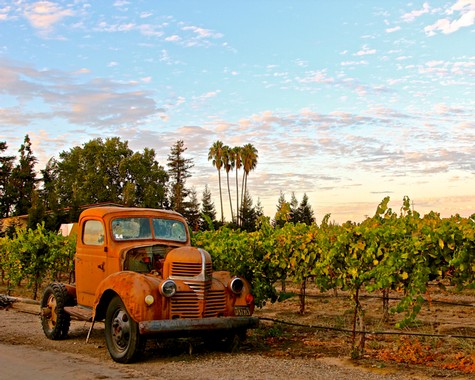
Old truck and palm trees at Harney Lane Winery estate
VINEX Regional Report — Lodi
August 8, 2019 — When even the local police cars have grapes daubed on the side, you know that you’re in serious wine country. And this is certainly the case in Lodi, wedged between the San Francisco Bay and the Sierra Nevada Mountains, a region so heavily imbued in wine culture that many local businesses, streets and even school names relate to the industry.
Bump into someone in the street and chances are they will work in the wine industry or be related to someone who is.
Commonly known as the Zinfandel capital of the world, Lodi’s vintages have historically been less prestigious than those of its bigger, more illustrious neighbours Sonoma and Napa counties. For years it was the go-to region for mass-market fruit used for producing California’s major supermarket wine brands.
But the founding of the Lodi WineGrape Commission in 1991 did much to boost the quality of grapes grown in the county, and helped it develop into the premium producer it is today. And its appellations have become increasingly respected, not only for its Zin, but also for other more eclectic varietals.
It is also increasingly being regarded as the test bed where Californian winemakers go to trial different varietals in a region where land is that much cheaper, and the climate and soils are perfect for producing premium and super premium wines. While an acre of prime vineyard land in Napa Valley could well cost an eye-watering $400,000 per acre, you could snap up the same land in Lodi for closer to $46,000.
This has resulted in a boom in the number of wineries in the area, from around only 10 in 2000 to around 90, many of whom are small, boutique operations looking to produce hand crafted premium wines...
Lodi is not only California’s biggest wine producing region, but is now responsible for 20% of the state’s premium wines, with over 100 varieties grown in the region, in more than 113,000 acres of vineyards. The region is also home to some of the oldest vines anywhere in the Golden State, dating back to the 1880’s when the first pioneers went west in the great gold rush.
“We have one foot in commodity and one foot in premium,” says (Stuart) Spencer (Executive Director of Lodi Winegrape Commission). “But overall we would like to see us migrate more to premium winemaking.” Read more.
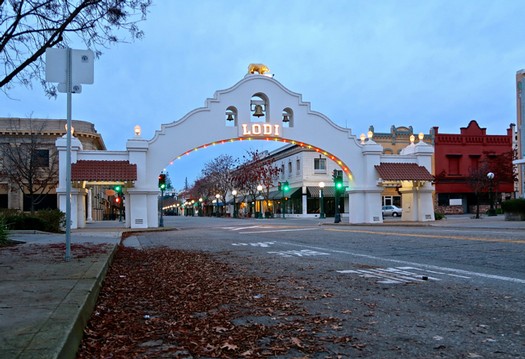
The City of Lodi's historic Lodi Arch on an early December 2019 morning